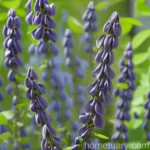What is false indigo (Baptisia ‘Lunar Eclipse’)?
False indigo, scientifically known as Baptisia ‘Lunar Eclipse’, is a stunning perennial plant that belongs to the Fabaceae family. This low-maintenance plant is native to North America and is highly valued for its beautiful flowers, attractive foliage, and its ability to fix nitrogen in the soil. The ‘Lunar Eclipse’ variety is particularly popular due to its unique three-colored flower spikes, making it an excellent addition to any garden or landscape. This blog post will delve into the various aspects of false indigo, ranging from its culture to uses, and from common diseases to propagation methods.
Key Takeaways – False Indigo (Baptisia ‘Lunar Eclipse’)
Before exploring the specific details of false indigo, let’s take a glance at the key takeaways associated with this fascinating plant:
- Plant Name: False indigo (Baptisia ‘Lunar Eclipse’)
- Perennial Type: False indigo is a perennial plant, meaning it lives for more than two years.
- Flower Colors: The ‘Lunar Eclipse’ variety of false indigo showcases stunning three-colored flower spikes.
- Attributes: It attracts wildlife, is deer resistant, and has the ability for nitrogen fixation.
- Water Needs: False indigo is a drought-tolerant plant.
- Soil Requirement: It requires well-draining soil.
- Sunlight: Thrives in full sun to part shade.
- Growth Rate: Has a moderate to fast growth rate.
Intrigued by false indigo? Let’s dive into the details of cultivating and caring for this captivating plant.
Culture
Uses
False indigo is prominently used for various purposes, including:
- Garden Ornament: False indigo ‘Lunar Eclipse’ is valued as an ornamental plant, primarily for its beautiful and unique flower spikes.
- Wildlife Attraction: It is known for attracting bees, butterflies, and other pollinators, making it a valuable addition to eco-friendly gardens.
- Nitrogen Fixation: False indigo is also used for its nitrogen-fixing abilities, enriching the soil where it grows.
Water
False indigo is remarkably drought-tolerant once established. Watering is essential during the plant’s initial growth and establishment phase. After that, false indigo can thrive on minimal water, making it an ideal choice for low-maintenance gardens and landscapes.
Sunlight
This perennial thrives in full sun to part shade. Adequate sunlight is essential for the robust growth and flowering of false indigo. However, it can also tolerate partial shade, making it adaptable to a variety of garden conditions.
Fertilizer
False indigo generally does not require significant fertilization if planted in nutrient-rich soil. However, a light application of a balanced fertilizer in early spring can promote healthy growth and abundant flowering.
Soil
The ideal soil for false indigo is well-draining and moderately fertile. It can tolerate various soil types, including sandy, loamy, or clay soils, as long as they are well-draining. The plant does not thrive in waterlogged or excessively moist soil conditions.
Pruning
Pruning false indigo is generally minimal. Deadheading the spent flower spikes can promote continuous blooming and maintain the plant’s tidy appearance. Additionally, cutting back the foliage after the growing season can help rejuvenate the plant for the following year.
Propagation
Method
False indigo can be propagated through several methods, including:
- Division: Divide mature plants in early spring to propagate new false indigo plants.
- Seed Propagation: False indigo can also be grown from seeds, sown directly into the garden in the fall or early spring.
Container Popularity
False indigo is well-suited for container gardening, particularly for those who have limited garden space. Its attractive foliage and unique flowers make it a striking addition to container displays on patios, balconies, or in courtyards.
Common Diseases
Disease Diagnosis
False indigo is generally resistant to most diseases and pests. However, like any plant, it may occasionally encounter issues such as:
- Powdery Mildew: A fungal disease that can affect false indigo, particularly in humid conditions or if the plant is overcrowded.
- Root Rot: This can occur in poorly draining soil or if the plant is overwatered.
Proper cultural practices, such as ensuring good air circulation around the plants and avoiding overwatering, can help prevent these diseases.
Common Pests
Pest Identification
False indigo is relatively resistant to most pests. However, it may occasionally face infestations from:
- Aphids: These small insects may gather on the new growth of false indigo, causing damage to the plant.
- Leafhoppers: Leafhoppers are another potential pest that may feed on the plant’s foliage.
Regular monitoring and the application of natural pest control methods can help manage these pest issues effectively.
Botanist’s Tips
- Companion Planting: False indigo complements a wide array of companion plants, including salvias, catmints, and ornamental grasses, creating visually appealing and ecologically beneficial garden designs.
- Perennial Borders: Integrating false indigo into perennial borders can provide structure, color, and a source of food for pollinators, enhancing the overall biodiversity of the garden.
Fun Facts
- The ‘Lunar Eclipse’ variety of false indigo is named after its enchanting three-colored flower spikes, resembling the phases of a lunar eclipse.
- False indigo has a historical use as a source of blue dye, derived from the plant’s flowers and used by Native American tribes and early European settlers.
Links to External Resources
For additional information on false indigo (Baptisia ‘Lunar Eclipse’), its care, and gardening tips, you can explore the following resources:
- Royal Horticultural Society – Baptisia australis
- Missouri Botanical Garden – Baptisia ‘Lunar Eclipse’
- University of Maryland Extension – False Indigo for Pollinators
By adopting the care tips and insights shared in this blog post, you can cultivate and enjoy the captivating beauty of false indigo ‘Lunar Eclipse’ in your garden or landscape, ensuring a thriving, low-maintenance addition to your outdoor space. Happy gardening!















